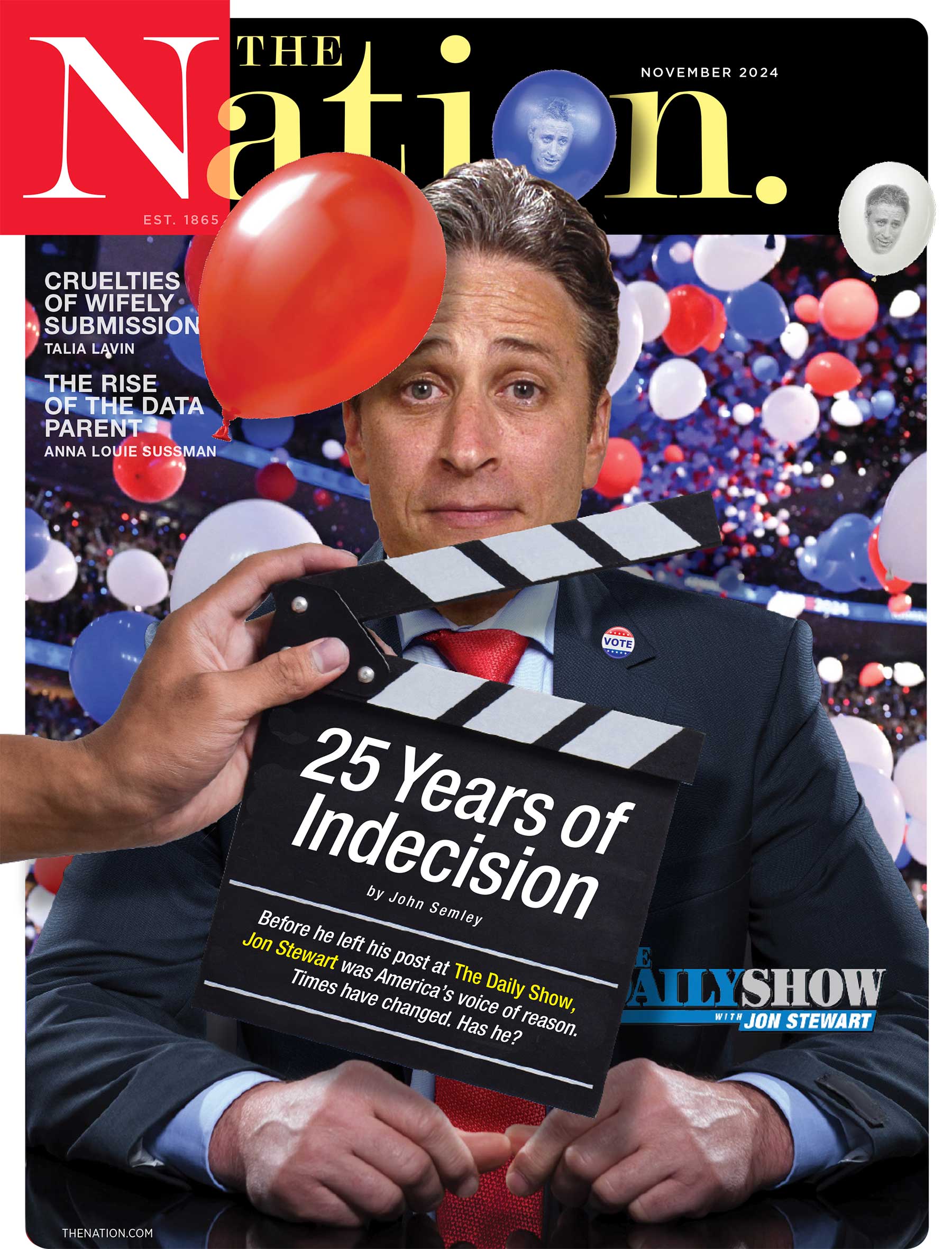 KEVIN W. FOWLER/APGeneral Motors workers test equipment along the assembly line.
KEVIN W. FOWLER/APGeneral Motors workers test equipment along the assembly line.
A lame-duck Congress balked on November 20 over a bailout for the auto industry, saying no action could be taken until the Big Three produced a viable plan for their own salvation. This was a victory for those who have been waging all-out war against a proposed government rescue package. Republican Senator Richard Shelby of Alabama has called the auto industry a “dinosaur” that should go extinct if it can’t compete in the free market, while many of his colleagues blame everything from the Big Three’s uninspired business model to unionized workers for Detroit’s potential collapse.
It is true that General Motors, Chrysler and Ford are culpable in great part for the crisis they face. They have long suffered from institutional torpor, from an inability to consolidate redundant brands and make relevant, fuel-efficient cars Americans want to buy. Nonetheless, allowing GM or any of the Big Three to fail would be catastrophic. The auto industry represents almost 4 percent of gross domestic product and 10 percent of industrial output by value. A study recently published by the Center for Automotive Research estimates that a collapse of the Big Three would eliminate nearly 3 million jobs in just the first year, as well as $21.1 billion in Social Security receipts and $24.7 billion in federal income tax payments. Bloomberg has reported that a collapse of GM alone could cost between $100 billion and $200 billion in government-funded benefits. This figure greatly exceeds proposed bailout numbers.
A prepackaged Chapter 11 bankruptcy for GM is an option that has been floated consistently in op-ed pages, but it would be a risky move for the faltering auto giant. A prepackaged Chapter 11 filing in a different era would have allowed GM to restructure, protect itself from creditors and emerge leaner and more financially sound. But as The New Republic‘s Jonathan Cohn recently wrote, in order to become productive while in bankruptcy protection, GM would need to be able to buy materials and parts from suppliers on credit through Debtor-in-Possession loans. The current credit climate makes it unlikely that GM would find creditors willing to lend the funds necessary to continue operations. In this case, GM would be forced into a Chapter 7 situation–total liquidation.
A government bailout of GM is the most viable solution to the crisis, but if Congress extends a lifeline it must be predicated on the condition that GM and others commit to systematic reform. Nelson Lichtenstein, a labor historian at the University of California, Santa Barbara, says the most pragmatic and progressive arrangement would be for a bailout of this sort to occur under the premise of “socially democratic planning” that would offer government loans to automakers as part of a larger economic recovery plan. Such a plan would include a jobs program like the New Deal-era Works Progress Administration, infrastructure projects and universal healthcare, which would alleviate many headaches for private enterprise. In return for government funds, the public sector should get equity in GM, a seat on its board, management oversight, a moratorium on golden parachutes for executives and ironclad agreements on fuel-efficiency standards. There should also be careful oversight of the administration of funds so that a bailout does not go toward propping up stockholders or allowing bond brokers to cash in on government investment.
Popular
"swipe left below to view more authors"Swipe →
Such an arrangement is vital to the real economy and is especially important to the industrial base and what remains of well-compensated blue-collar work in America. Gary Chaison, a professor of industrial relations at Clark University, notes that one of the ugliest aspects of the continued debate over the Big Three has been a virulent, thinly cloaked antiworker narrative. Washington Post columnist Robert Samuelson recently wrote that a GM bankruptcy could serve as a reminder to all of the “social costs of…overpriced unionized labor.” He and other finger-wagging pundits, politicians and free-market adherents have blamed unionized workers (with their solid wages and benefits) for their complicity in the crisis GM is facing.
These arguments falsely vilify working people and stem from a superficial understanding of the modern automotive industry. Historically, the auto industry has provided good middle-class jobs that have come with high wages, impressive healthcare and pension benefits packages, disability and overtime pay–the kinds of jobs that are in too short supply in today’s economy. But in recent decades, much of GM’s manufacturing has been moved to nonunion parts plants in the South, allowing the company to drive down labor costs by avoiding United Auto Workers strongholds in the industrial Midwest. This, coupled with last year’s agreement by the UAW to swallow concessions on a two-tiered pay scale, has dramatically lowered labor costs for GM. The UAW has also agreed to take over retiree health costs in 2010. These concessions–opposed by many union members for creating a divided workforce–have allowed GM to close the labor cost gap significantly with foreign manufacturers like Toyota. Analysts estimate that the 2007 agreement has saved GM $500 million in labor costs since its signing, and the company is set to save $4 billion annually starting in 2010.
Increased scrutiny must also be applied to the credit side of the equation. GMAC, GM’s auto loan company, is the parent company of the nation’s fifth-largest mortgage lender, Residential Capital, which is teetering on the brink of collapse under the weight of toxic assets and plummeting revenue because of the crippled housing market. ResCap lost $1.9 billion last quarter alone, putting significant strain on GM, which owns 49 percent of GMAC. The flailing GMAC–majority owned by Cerberus Capital Management, John Snow and Dan Quayle’s private equity firm–has recently applied for bank holding company status. Becoming a bank holding company would provide much needed oversight and transparency, but GMAC must also be compelled to reform.
The loan company markets a high-risk investment to GM employees called Demand Notes. These offer check-writing privileges and a 5.25 percent return on investments, which are not FDIC-insured. GM workers have $3.9 billion sunk into these short-term debt obligations; should GMAC go down, they stand to lose retirement funds, college savings, the works. This dangerous arrangement deserves careful attention. As Robert Scott, an economist at the Economic Policy Institute, put it, “We cannot have another Enron.” (When that energy company went bankrupt in 2001, more than 4,000 employees lost not only their jobs but also their life savings.)
In exchange for a government bailout of the auto industry as part of a broader economic revitalization program, automakers must also be required to continue research and development of cars that can compete in a gas-starved age. According to Jay Baron, director of the Manufacturing, Engineering and Technology Group at the Center for Automotive Research, engineers in Detroit are already working overtime to achieve this goal. Automakers are designing lighter-weight vehicles by experimenting with “exotic materials normally associated with aerospace,” like extremely thin steel, aluminum and reinforced composites. And then there is the much-vaunted Chevy Volt, a plug-in hybrid GM engineers hope will be able to go forty miles on one charge and recharge on the road. The Volt is the hard-up company’s double-down bet, a sexy, eco-friendly machine that company execs hope will be to GM what the iPod was to Apple. But it will take a quantum leap in innovation to pull this off. The Volt’s lithium-ion battery is priced at $10,000-$30,000, far too costly for the car to be marketed to a broad consumer base.
A bailout could provide the funds necessary to complete research and development of the lithium-ion battery and other potentially profitable green technologies. It will take time for the battery to become viable, as issues with cooling, size and cost continue to challenge engineers. Government support could help expedite this process while paving the way for the creation of jobs in related industries. Brett Smith, also of the Center for Automotive Research, thinks the lithium-ion battery could present an opportunity not only to reduce carbon emissions but also to create the kind of green-collar jobs that could reinvigorate the slumping manufacturing sector. Currently, Smith explained, most battery cells are manufactured in Asia, but mass production of the Volt could entail opening factories on US soil. The battery could become a niche product for the United States, but only if the government ensures that American automakers, in attempting to cut costs, do not buy batteries produced abroad. “In trying to reduce our reliance on foreign oil,” Smith warned, “we should not replace it with a reliance on imported batteries.”
Unlike the $290 billion already thrown at overleveraged financial institutions, a bailout along these lines would yield productive results for the real economy and would initiate a broader federal commitment to reindustrializing the country through a much-needed economic recovery program. If, as a part of this recovery plan, GM is given another shot at making a product people want to buy, at again generating well-paid jobs for American workers while moving domestic industry away from its reliance on fossil fuels, then that would be a government bailout worth considering.


